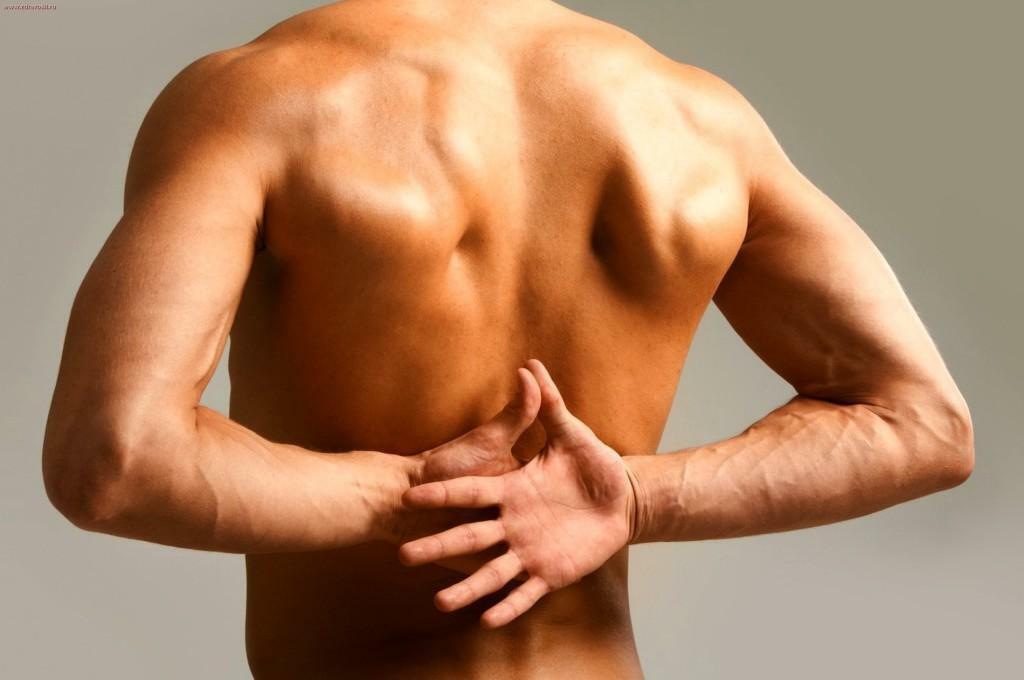Tuberculosis is one of the most dangerous but common infectious diseases. In most people, this pathology is associated with lung diseases, but mycobacterium tuberculosis( MBT) can affect other organs, being carried from the main source by blood or by lymphatic vessels. The second most common is tuberculosis of bones and joints, it accounts for up to 5% of all tubercular localizations. They get sick with this form at any age, but children suffer more often and more.
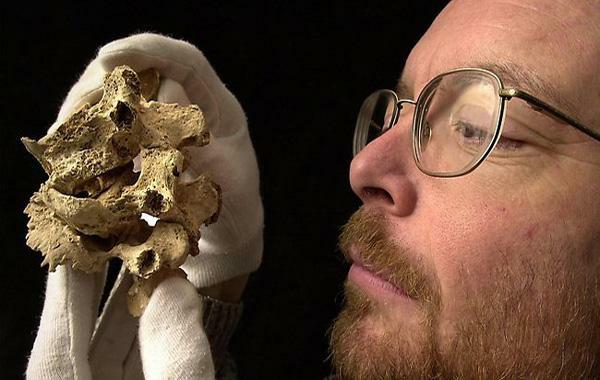
Tuberculosis of bones. Symptoms

Tuberculosis of bones and joints
In addition to childhood, the factors predisposing to infection and spread to bone and joint structures are unfavorable living conditions, malnutrition, alcohol abuse, excessive physical activity and skeletal injuries.

Fistulas for tuberculosis of the knee joint
The danger of the disease lies in the fact that the symptoms are often blurred. For this reason, damage to the bone and joint structures is detected already in the late stages.
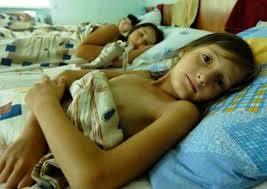
TB can occur in the later stages
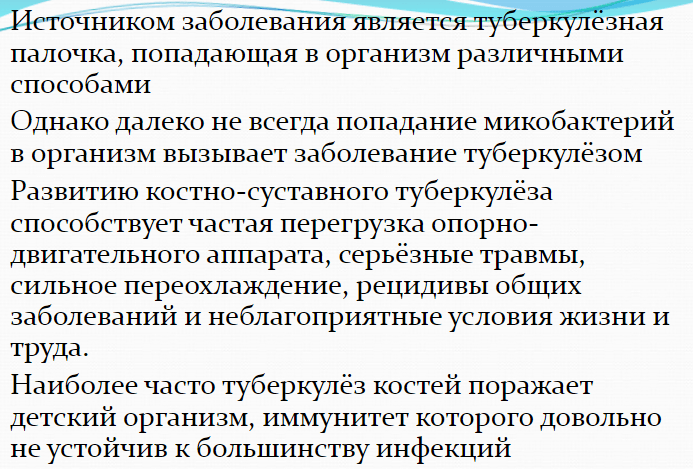
disease Source and development
material Content
- 1 Signs
- 1.1 tuberculosis of bones and joints Tuberculosis of the spine
- 2 clinical picture of tuberculosis of bones
- 3 Symptoms of tuberculous lesions of the joints
- 4 Features manifestations of tuberculous-allergic arthritis
- 4.1 Video - Tuberculosis
Signs of tuberculosis of bones and joints
All symptoms of tuberculosis can be divided into two broad categories:
- are common;
- local.
The first group includes systemic manifestations of intoxication, which almost always occurs in childhood and is less common in adults. In some cases, such symptoms may be absent. The degree of their severity depends on the intensity of the tuberculosis process itself, primarily in the lungs.

Development of the disease

Defeat of bones with tuberculosis
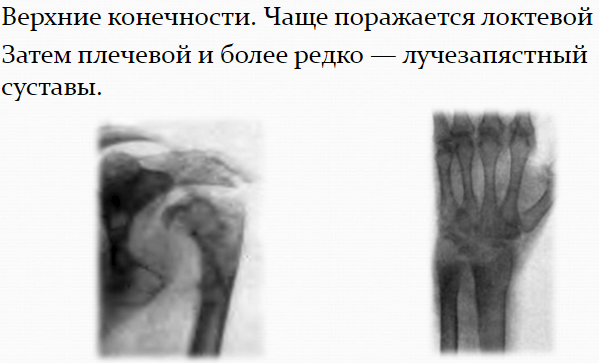
Defeat of upper extremities
To common manifestations include:
- fatigue;
- irritability;

Irritability and fatigue as symptoms
- constant or often recurring without apparent cause subfebrile temperature( about 37 degrees);
- poor sleep and appetite;

Poor sleep and appetite
- decreased activity.

Reduced activity
Local manifestations of tuberculosis of bones and joints are the pain syndrome. The pain is often aching and unstable and is not always localized clearly in the place where the process of inflammation develops, but can radiate( spread).

Pain in the area of affected joints locally or spreading
Note! If the pains localized in various structures of the skeleton do not pass or die away slightly after taking pain medication, then this is the reason for immediate medical attention.
Local manifestations depend on the stage of the disease. In the process of development of pathology in the place of the affected joint, there is swelling, redness. Due to the increasing pain, contraction appears( restriction of movement).Gradually, with the progression of the process, deformation of the bone may occur, the tone of the surrounding muscles may increase, which becomes painful during palpation.
Important! The symptoms indicated in the article are an excuse to contact the doctor who will put the final diagnosis and prescribe a therapy. Self-diagnosis and treatment are unacceptable.
The peculiarities of the symptoms are also affected by the localization of the inflammatory process. In accordance with this parameter, there are 3 main forms of osteoarticular defeat of tuberculosis:
- spondylitis - spine disease;
- osteitis - inflammation of the bones;
- arthritis is a joint disease.
A special type is tuberculosis-allergic arthritis, which is the reaction of the joint membrane to the remote location of the MBT.
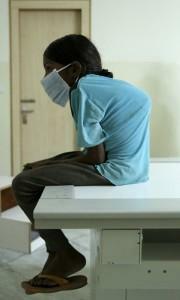
Expressed curvature of the spine with bone tuberculosis
Spinal tuberculosis
Tuberculosis spondylitis, or Pott's disease, accounts for approximately 40% of all forms of osteoarticular tuberculosis. In the overwhelming majority of cases, 2 vertebra are simultaneously affected, and only about 20% of the inflammatory region is wider. More often the disease affects the body of the vertebrae, less often the processes.
A patient who developed a spinal cord injury complains of weakness, fatigue and back pain, which worries during the night. Pain syndrome is determined with a slight pressure on the spinous processes of the vertebrae.
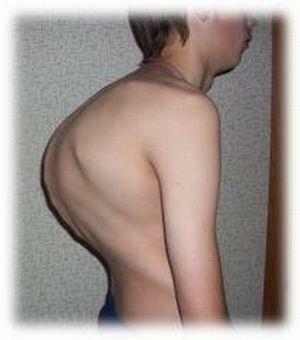
Tuberculosis of the bones of the spine
In the course of the development of the disease, old ones become worse and new symptoms appear.
- Gradually, a person develops an analgesic posture, muscles are in a tone to resist developing deformations in the vertebrae and intervertebral articulations.
- Muscle atrophy develops, which previously were in a tonus.
- Intoxication may be more pronounced.
- Because of the destruction of the vertebral bodies, the curvature of the spine is formed.
- The patient's gait changes.
- Movement in the affected area becomes chained or nonexistent.
- A common symptom of progressive spondylitis in tuberculosis is cold abscessing. At the same time there are no such symptoms as pain, fever, redness of the skin. Abscess can result in the formation of fistulas with curdled suppuration.
The preferred location for spondylitis is the 10th vertebra( thoracic region).However, other departments may be affected. Symptoms are determined by the localization of the inflammatory process.
| Location of inflammation | Characteristic manifestations |
|---|---|
| Neck section | Pain spreads to the nape and into the area above the scapula. Soreness is characteristic in the palpation of the patient avoids the headache, and in the sitting position tries to prop her under the chin with her hand. Abscessing can be manifested by soft, mobile swelling, localized on both sides of the spine, sometimes it spreads into space behind the pharynx. |
| Nursing department | Soreness radiates to the chest and abdomen. Tingling in the extremities can be observed. The back is in tension. To lift something off the floor, the patient crouchs, trying to keep his back straight. If necessary, to turn back, a person does not turn the body, but crosses with his feet. Cold abscess manifests itself as a soft tumor to the right or left of the spinal column. With the destruction of the vertebrae, a hump is formed. |
| Lumbar department | Pain gives to the legs. |
Severe consequence of tuberculous spondylitis is partial or complete paralysis of the limbs, as well as disruption of the internal organs due to the damage to the spinal cord and nerves.
Clinical picture of tuberculosis of bones

Phases of disease
It is with inflammation of the bone tissue( vertebral body) that the development of the infectious process in the spine usually begins. Ostitis is also considered the beginning of inflammatory phenomena in the joints.
Bone form of tuberculosis is more often affected by children and adolescents. Adults get sick much less often. Ostitis can affect any bones. Most inflammation occurs in areas rich in bone marrow, for example, in the epiphyses( ends) of tubular bones. An extremely rare form is inflammation in the diaphysis( the middle part of the tubular bone containing the bone marrow).Bones in the place of formation of the granuloma thicken. At the time of inflammation outside the bone structure, fractures are often recorded.
At the very beginning of tuberculous ostitis, pain does not bother a person, since the focus is located in the thickness of the bone where there are no nerve endings. Pain syndrome and other local symptoms usually appear during the transition of inflammation to the periosteum, near joints or surrounding soft tissues. In childhood, in the first stages, the phenomenon of active growth of cartilage and bone near the joint is well expressed, which is manifested by the rapid growth of the limb. The smaller the age of the child, the more noticeable these changes are.
As for spondylitis, abscessing is characteristic, with the breakthrough of which on the surface of the skin can form fistulas.
Symptoms of tuberculosis of joints
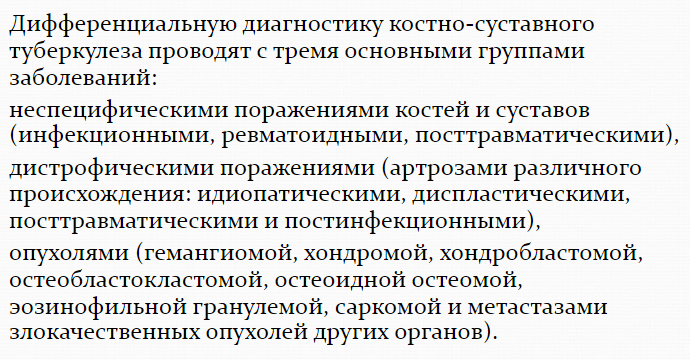
Difiagnosis
Tuberculosis often affects large joints, which account for a large load. Among all osteoarticular forms, 20% are inflammation of the hip and knee joint.
Transition of the infectious process from the bone to the joint can occur in two ways that differ in symptoms.
- When germination of granulation disease is not so active. This option is more typical for adults.
- With weak immunity, for example, in children, infection of the joint occurs when pus breaks out of the bone. For such a case, there is a strong inflammation, accompanied by sharp pain, high body temperature and the inability to move in the affected joint. Destruction very quickly spreads to the entire bone, causing its thinning.

Pathological anatomy of tuberculosis of bones and joints
In any case, the articular form is characterized by several symptoms:
- pain;
- intoxication;
- swelling around the joint;
- full or partial immobilization;
- lameness, if leg joints are damaged;
- atrophy of surrounding tissues.
In many cases, joint ankylosis is formed( fusion of articular surfaces and complete immobilization of the joint) and shortening of the limb.
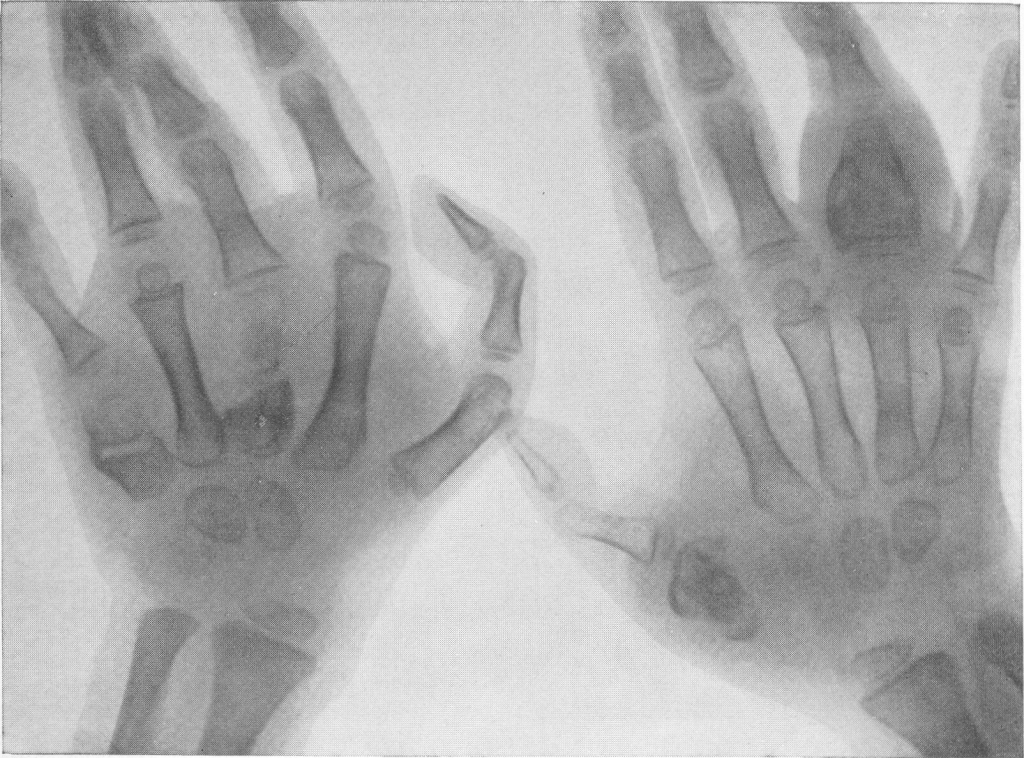
Spina ventosa tuberculosa - multiple lesions of phalanges and metacarpal bones in a child with generalized hematogenous tuberculosis
Specific features of tuberculous-allergic arthritis
Ponce disease is an allergic reaction of the inner articular surface to an infectious focus located elsewhere. In this case, there is no change in the bone.
An abscess can form. The joint is deformed, ankylosis.
Due to the fact that different forms of tuberculosis of bones and joints for a long time occur with unexpressed symptoms, it is worthwhile even to consult a doctor even with mild pains and general impassable indisposition. In addition, an important preventive measure is the conduct of tuberculin samples or an annual chest X-ray to identify foci in the lungs. Especially in Russia, unfortunately, the situation with tuberculosis remains unfavorable.

Diagnosis
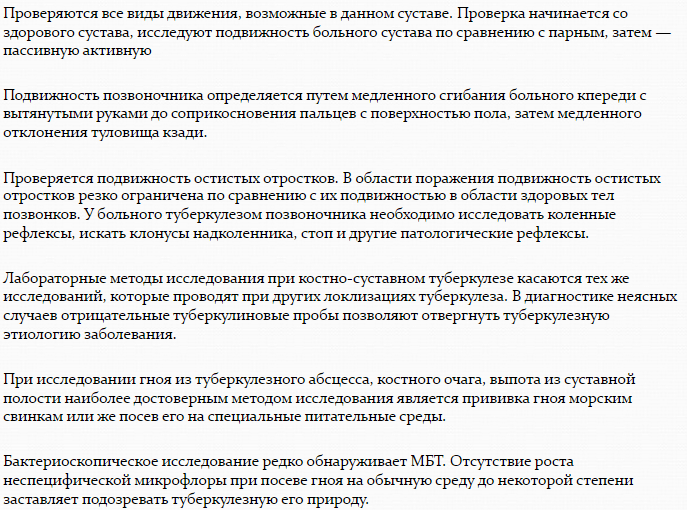
Diagnosis



